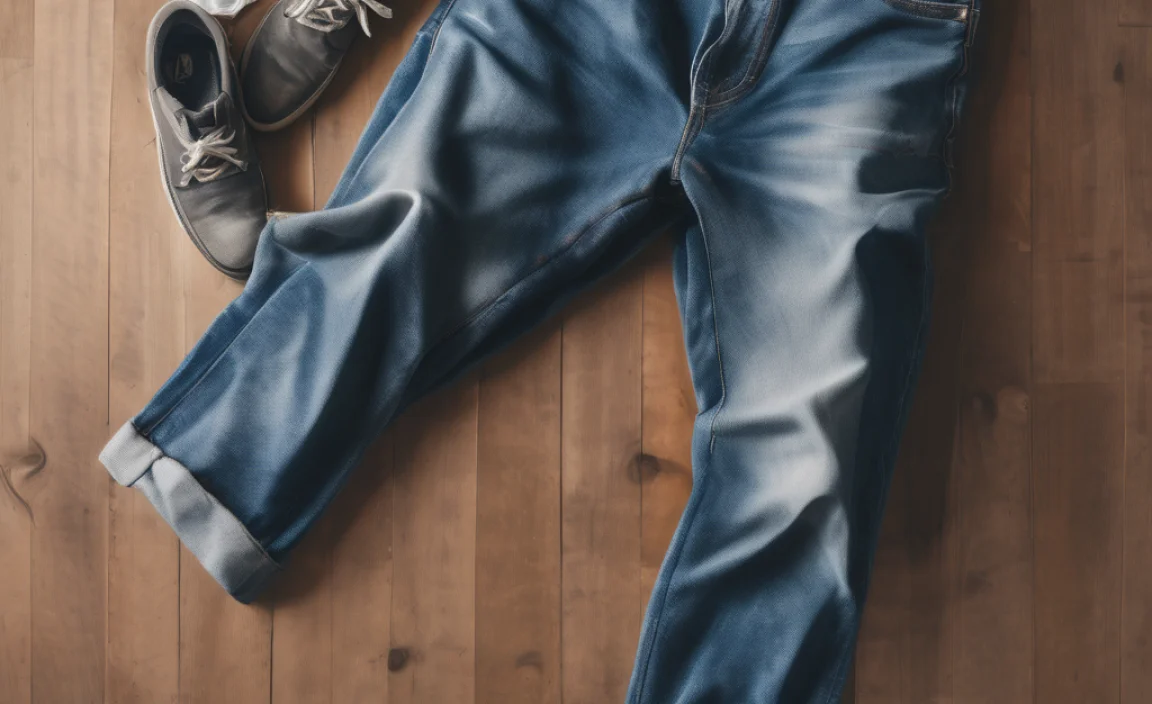Quick Summary: Learn how to hem dad jeans easily at home! This guide offers proven, step-by-step methods, with or without a sewing machine, to achieve a perfect, custom fit for your favorite jeans. Get ready to wear them with confidence!
Hemming Dad Jeans: Your Go-To Guide for the Perfect Fit

Dad jeans are back, and they’re fantastic! But sometimes, that perfect vintage look comes with a length that’s just a little… off. Too long and they drag, too short and they can look awkward. Getting them just right can feel like a challenge, especially if you’re new to DIY fashion. Don’t worry, though! This guide will walk you through simple, proven ways to hem your dad jeans at home. You’ll feel confident and ready to rock your perfectly fitting denim in no time.
We’ll cover everything you need, from measuring to the final stitch, making sure you get that effortless, tailored look. Let’s get started and make those jeans fit like they were made just for you!
Why Hemming Your Dad Jeans Matters

Dad jeans, with their relaxed fit and often higher waist, are incredibly versatile. However, their original design might not account for everyone’s specific leg length. A proper hem ensures:
- Improved Aesthetics: Jeans that end at the right spot on your shoe or ankle look intentional and stylish.
- Comfort and Functionality: No more tripping over excess fabric or having your jeans get dirty from dragging on the ground.
- Extended Garment Life: Properly hemmed jeans are less likely to fray unevenly or wear out prematurely at the bottom.
- Personalized Style: You can choose a hem length that perfectly complements your footwear and personal style.
Tools You’ll Need for Hemming Dad Jeans

Gathering the right tools makes the process smoother. Here’s what you’ll likely need, depending on your chosen method:
| Tool | Description | When to Use |
|---|---|---|
| Fabric Scissors | Sharp scissors specifically for cutting fabric. | Essential for all methods. |
| Measuring Tape | Flexible tape for accurate body and fabric measurements. | Essential for all methods. |
| Fabric Marker or Chalk | Temporary marker to draw a hemming line. | Essential for all methods. |
| Pins | To secure folded fabric before sewing. | Essential for sewing methods. |
| Sewing Machine | For a quick, durable, and professional-looking hem. | Recommended for permanent hems. |
| Needle and Thread | For hand-sewing or for machines. | Necessary for hand-sewing; good to have as a backup. |
| Iron and Ironing Board | To press creases and create crisp folds. | Highly recommended for neatness in all methods. |
| Seam Ripper | To undo existing seams if needed (e.g., for a raw hem). | Optional, but useful for specific styles. |
| Hemming Tape (Iron-On) | A fusible web to bond fabric edges without sewing. | Alternative to sewing for quick hems. |
Step-by-Step: How to Measure and Mark Your Dad Jeans

Accurate measurement is key to a perfect hem. Here’s how:
- Wear Your Jeans: Put on the dad jeans you want to hem. Make sure they are sitting at your natural waist.
- Choose Your Footwear: Wear the type of shoes you’ll most often wear with these jeans. The hem length can vary slightly depending on whether you’re wearing sneakers, boots, or heels.
- Determine Desired Length: Stand in front of a mirror. Let the jeans fall naturally. You can let them slightly bunch at the shoe for a casual look, or have them end right at the top of the shoe for a cleaner line. For dad jeans, a slight break (where the fabric just kisses the top of your shoe) is often ideal.
- Mark the First Leg: Using your fabric marker or chalk, make a small mark on the outside seam of one leg where you want the hem to fall. It’s helpful to mark it slightly higher than your ideal length, accounting for the fold you’ll create.
- Measure and Mark the Second Leg: Take off the jeans. Lay them flat on a table. Use your measuring tape to measure the distance from the waist to the mark you made on the first leg. Transfer this exact measurement to the second leg, ensuring it’s marked at the same point on the outside seam. You can also fold the jeans in half lengthwise and match the hems, then mark both ankles simultaneously.
- Add Hem Allowance: Decide how much fabric you want to fold over for the hem. For a typical jeans hem, 1 to 2 inches is standard. Mark this additional length below your initial marks on both legs. This extra fabric will be folded and sewn.
- Create a Straight Hemline: Connect your markings with a straight line using your fabric marker or chalk. This line indicates where you will fold the fabric. If you want a double-folded hem for a cleaner finish, mark a second line about 0.5 to 1 inch above the first fold line.
Method 1: Hemming Dad Jeans with a Sewing Machine

This is the most durable and professional-looking method, perfect for a long-lasting hem. For instructions on a specific machine, always refer to its user manual.
Preparing Your Jeans for the Machine
Ensure your jeans are clean and dry. Lay them flat and press out any wrinkles to make marking and sewing easier.
Step-by-Step Sewing Machine Hem
- Fold and Press: Fold the excess fabric up along the marked line so the raw edge is concealed. Press this fold firmly with your iron. For a double-folded hem, fold again along your second marked line, encasing the raw edge. Press this second fold.
- Pin in Place: Secure the folded hem with pins, placing them perpendicular to the fold. Ensure the pins are close enough together to hold the fabric snugly but not so close that they interfere with your sewing machine’s presser foot.
- Set Up Your Sewing Machine:Thread your machine with a strong thread that matches your jeans. Use a needle appropriate for denim (a denim or jeans needle, often a size 14 or 16, is recommended). Set your stitch length to a medium-to-long setting (around 2.5-3.0 mm) suitable for sturdy fabrics.
- Sew the Hem: Place the pinned hem under the presser foot, aligning the edge of the fold with the presser foot. Sew along the folded edge, following the original seam line of the jeans if possible, or about 1/8 inch from the folded edge. Remove pins as you sew.
- Reinforce the Stitching: When you reach the starting point, backstitch for about half an inch to secure the seam.
- Trim Excess Thread: Trim any loose threads for a clean finish.
- Press the Hem: Once sewn, give the hem a final press with your iron.
Tip: Denim can be thick, so sew slowly and steadily. If your machine struggles, you might need to adjust the presser foot pressure or use a heavier-duty needle.
Method 2: Hemming Dad Jeans with Iron-On Hemming Tape
This is a fast, no-sew option for a quick fix or if you don’t have a sewing machine.
Step-by-Step Iron-On Hemming Tape
- Prepare and Mark: Follow steps 1-7 from the “How to Measure and Mark Your Dad Jeans” section.
- Apply Hemming Tape: Cut a piece of hemming tape to fit the length of the hem. Place the tape inside the folded hem, between the two fabric layers. Ensure it is centered and covers the raw edge. Refer to the specific hemming tape instructions as they can vary.
- Iron the Hem: Heat your iron to the temperature recommended on the hemming tape packaging (usually a medium-high setting). Place the folded hem on your ironing board. Press the iron firmly onto the hem for the recommended duration (typically 5-10 seconds), ensuring the tape adheres to both layers of fabric. Move the iron slowly along the entire hem.
- Let it Cool: Allow the hem to cool completely before moving the jeans. This helps the adhesive set properly.
- Test the Bond: Gently tug on the hem to ensure it’s securely attached. Repeat ironing if necessary.
Pros and Cons of Hemming Tape:
| Pros | Cons |
|---|---|
| Very fast and easy. | May not be as durable as sewing. |
| Requires no sewing skills or machine. | Can sometimes come undone after multiple washes or dry cleaning. |
| Provides a clean, invisible finish if applied correctly. | May create a slightly stiffer hem. |
Method 3: Hand-Sewing Your Dad Jeans Hem
For a classic, no-machine approach, hand-sewing is a great option. It allows for a lot of control.
Step-by-Step Hand-Sewing a Hem
- Prepare and Mark: Follow steps 1-7 from the “How to Measure and Mark Your Dad Jeans” section.
- Fold and Press: Fold and press the hem as you would for machine sewing, creating a double fold for durability, or a single fold for a simpler finish.
- Thread Your Needle: Cut a length of strong thread (double it for extra strength) and knot one end.
- Start Sewing: Begin at an inconspicuous spot, like an inside seam. Use a blind hem stitch if possible for an invisible finish, or a small, consistent whipstitch for a more secure but visible hem. For a blind hem stitch, catch only a few threads of the jean fabric on the outside and then pick up the folded edge of the hem on the inside.
- Maintain Even Stitches: Aim for small, even stitches to create a neat appearance. Keep the tension consistent.
- Secure the End: When you’ve completed the circle, make a few small stitches and tie off the thread securely.
- Press the Hem: Iron the finished hem.
Tip: A thimble can protect your finger while pushing the needle through thick denim.
The Raw Hem: A Trendy Alternative
Dad jeans often lend themselves well to a casual, raw hem. This involves cutting off the excess fabric and deliberately fraying the edge.
How to Create a Raw Hem
- Measure and Cut: Determine your desired length and measure. Instead of folding, simply cut the jeans straight across at your marked hemline.
- Unfray the Edge: To encourage fraying, you can use a seam ripper or a stiff brush to pull out some of the weft (horizontal) threads along the cut edge.
- Wash and Dry: Wash and dry your jeans. This will help the fraying process naturally.
- Trim (Optional): After washing, you can trim any overly long threads to maintain a desired fringe length.
Note: Raw hems will continue to fray over time with wear and washing. This is part of their charm!
Common Dad Jean Hemming Issues and Solutions
Even with the best intentions, you might encounter a few hiccups. Here are some common problems and how to fix them:
| Issue | Solution |
|---|---|
| Uneven Hemline | If you notice the hem is uneven after sewing, you can often trim it carefully with sharp scissors. For significant unevenness, you might need to unpick the hem and re-mark and re-sew. Always start with accurate marking. |
| Stretched Out Fabric | Denim, especially when wet, can stretch. Handle with care. If the hemline stretches during sewing or ironing, gently press it back into shape. You can also try using a walking foot on your sewing machine to ensure even fabric feeding. For hand sewing, keep stitches small and consistent. |
| Needle Breaking or Skipping Stitches | This usually happens when using the wrong needle or thread for denim. Switch to a denim needle (size 14 or 16) and strong, quality thread. Ensure your sewing machine is properly threaded. |
| Hemming Tape Not Sticking | Ensure your iron is hot enough and you are pressing for the recommended time. Make sure the fabric is clean and dry. Sometimes, thicker denim requires longer pressing times or a stronger hemming adhesive. |
| Fabric Bunching While Sewing | This can be due to uneven tension, too short a stitch length, or the fabric not feeding evenly. Check your machine’s tension settings. Use a longer stitch length. A walking foot can help significantly. |
Maintaining Your Hemmed Dad Jeans
To keep your newly hemmed dad jeans looking great:
- Washing: Wash inside out in cold water on a gentle cycle. This helps preserve the color and minimize stress on the hem.
- Drying: Air dry whenever possible. If using a dryer, use a low heat setting. Remove jeans while slightly damp to prevent excessive shrinkage or wrinkling.
- Ironing: Iron on the reverse side of the hem if needed. Use a medium to high heat setting appropriate for denim.
- Repairs: Check for any loose threads or seams regularly and mend them promptly to prevent further damage.
Frequently Asked Questions About Hemming Dad Jeans
Q1: How much fabric should I leave for a dad jeans hem?
For a standard hem, leaving 1 to 2 inches of fabric for folding is generally sufficient. This allows for a neat double fold or a single fold with enough material to secure. For a raw hem, you don’t need extra allowance; just cut to your desired length.
Q2: Can I hem my dad jeans without a sewing machine?
Absolutely! You can use iron-on hemming tape or hand-sew the hem. Both methods are effective for achieving a custom fit.
Q3: How do I make sure my jeans are evenly hemmed?
The best way is to measure carefully. Wear the jeans with your intended shoes, mark the length on one leg, take them off, lay them flat, and then transfer that exact measurement to the other leg. Use a measuring tape for accuracy.
Q4: What is the best stitch for hemming jeans?
For a machine-sewn hem, a straight stitch is common. For a more invisible finish, a blind hem stitch is ideal if your machine has it. For hand-sewing, a blind stitch or a small whipstitch works well.
Q5: My jeans are stretched out. How can I hem them properly?
Always try to hem jeans when they are dry. If they have stretched, try to gently coax them back to their original shape before measuring. Sewing with a walking foot can help prevent further stretching as you sew.
Q6: How do I hem jeans if I want to keep the original distressed hem?
If you want to keep the original finished look of the bottom hem, you’ll want to detach it carefully with a seam ripper, measure and cut your jeans to the new desired length, and then reattach the original hem using a sewing machine. It’s more complex but preserves the original look.
Conclusion: Confidence in Every Step
Hemming dad jeans doesn’t have to be intimidating. By following these detailed steps, whether you choose the precision of a sewing machine, the speed of hemming tape, or the control of hand-stitching, you can achieve a perfect fit. You’ve learned how to measure accurately, prepare your denim, execute the chosen hemming method, and even tackle alternative styles like the raw hem. Remember to always use sharp tools and take your time, especially when working with sturdy fabrics like denim.
With your dad jeans now perfectly altered, you can step out with renewed confidence, knowing











